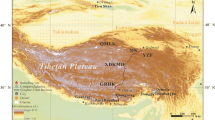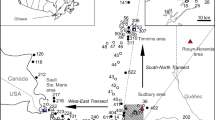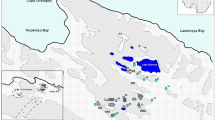Abstract
To provide insight into dust sources in snow deposited during the non-monsoon period on the Tibetan Plateau, detailed post-Archean Australian shale (PAAS)-normalized rare earth element (REE) distribution patterns and variations in REE tracers, such as La/Yb, La/Er, and Gd/Yb with depth, as well as the distribution of samples in the plots of REE ratio pairs, such as La/Yb vs. Y/ΣREE, La/Er vs. Gd/Er, and Y/La vs. Nd/Er, were compared in seven potential dust source areas in Asia. Snow samples from five glaciers, i.e., Qiumianleike (QMLK), Meikuang (MK), Yuzhufeng (YZF), Xiaodongkemadi (XDKMD), and Gurenhekou (GRHK), were collected from April 26 to May 13 before the onset of monsoon activity. The results show that dust trapped in snow pits from the studied glaciers, i.e., QMLK, MK, XDKMD, and GRHK, has varying degrees of contribution from the Taklimakan Desert, Qaidam Basin, and the surface soil of the Tibetan Plateau. There are signals of the Tengger and Badain Jaran Desert and Chinese Loess in the MK and XDKMD snow pit samples or in the QMLK and GRHK surface samples from the REE tracers; however, from the point of view of the land location, the three dust sources should not be the major contributors. Signals of dust from the Indian Thar Desert were occasionally detected from the MK, YZF, and XDKMD snow pit samples and GRHK surface snow samples, implying the intrusion of early Indian monsoon activities to the sites. The dust signal from the Thar Desert in India from the YZF glacier is significantly greater than that from the XDKMD and MK glaciers. These findings were also supported by the tracer of dust transmitted to the three snow pits through the air mass backward trajectories. The new finding of this study is that dust from the Indian Desert can even reach the Kunlun Mountains in the northern region of the Tibetan Plateau. The conclusions are helpful in interpreting the sources of dust and the pollutants absorbed by dust particles, as well as the extent of the impact of Indian monsoon activities at the end of the non-monsoon season on the plateau.










Similar content being viewed by others

Data availability
Data are available from the corresponding authors on request.
References
Dong Z, Kang S, Qin D, Shao Y, Ulbrich S, Qin X (2018) Variability in individual particle structure and mixing states between the glacier-snowpack and atmosphere in the northeastern Tibetan Plateau. Cryosphere 12:3877–3890. https://doi.org/10.5194/tc-12-3877-2018
Du Z, Xiao C, Ding M, Li C (2018) Identification of multiple natural and anthropogenic sources of dust in snow from Zhongshan Station to Dome A, East Antarctica. J Glaciol 64:855–865. https://doi.org/10.1017/jog.2018.72
Ferrat M, Weiss DJ, Strekopytov S, Dong S, Chen H, Najorka J, Sun Y, Gupta S, Tada R, Sinha R (2011) Improved provenance tracing of Asian dust sources using rare earth elements and selected trace elements for palaeomonsoon studies on the eastern Tibetan Plateau. Geochim Cosmochim Acta 75:6374–6399. https://doi.org/10.1016/j.gca.2011.08.025
Gabrielli P, Wegner A, Petit JR, Delmonte B, De Deckker P, Gaspari V, Fischer H, Ruth U, Kriews M, Boutron C, Cescon P, Barbante C (2010) A major glacial-interglacial change in aeolian dust composition inferred from rare earth elements in Antarctic ice. Quat Sci Rev 29:265–273. https://doi.org/10.1016/j.quascirev.2009.09.002
Gaiero DM, Depetris PJ, Probst JL, Bidart SM, Leleyter L (2004) The signature of river- and wind-borne materials exported from Patagonia to the southern latitudes: a view from REEs and implications for paleoclimatic interpretations. Earth Planet Sci Lett 219:357–376. https://doi.org/10.1016/s0012-821x(03)00686-1
Han Y, Fang X, Kang S, Wang H, Kang F (2008) Shifts of dust source regions over central Asia and the Tibetan Plateau: Connections with the Arctic oscillation and the westerly jet. Atmos Environ 42:2358–2368. https://doi.org/10.1016/j.atmosenv.2007.12.025
Jia R, Liu Y, Chen B, Zhang Z, Huang J (2015) Source and transportation of summer dust over the Tibetan Plateau. Atmos Environ 123:210–219. https://doi.org/10.1016/j.atmosenv.2015.10.038
Joswiak DR, Yao T, Wu G, Tian L, Xu B (2013) Ice-core evidence of westerly and monsoon moisture contributions in the central Tibetan Plateau. J Glaciol 59:56–66. https://doi.org/10.3189/2013JoG12J035
Kaspari S, Mayewski PA, Handley M, Kang S, Hou S, Sneed S, Maasch K, Qin D (2009) A high-resolution record of atmospheric dust composition and variability since AD 1650 from a Mount Everest ice core. J Clim 22:3910–3925. https://doi.org/10.1175/2009jcli2518.1
Kutuzov S, Legrand M, Preunkert S, Ginot P, Mikhalenko V, Shukurov K, Poliukhov A, Toropov P (2019) The Elbrus (Caucasus, Russia) ice core record - Part 2: history of desert dust deposition. Atmos Chem Phys 19:14133–14148. https://doi.org/10.5194/acp-19-14133-2019
Lau KM, Kim MK, Kim KM (2006) Asian summer monsoon anomalies induced by aerosol direct forcing: the role of the Tibetan Plateau. Clim Dyn 26:855–864. https://doi.org/10.1007/s00382-006-0114-z
Li C, Kang S, Zhang Q (2009) Elemental composition of Tibetan Plateau top soils and its effect on evaluating atmospheric pollution transport. Environ Pollut 157:2261–2265 https://doi.org/10.1016/j.envpol.2009.03.035
Li C, Kang S, Zhang Q, Gao S (2012) Geochemical evidence on the source regions of the Tibetan Plateau dusts during non-monsoon period in 2008/09. Atmos Environ 59:382–388. https://doi.org/10.1016/j.atmosenv.2012.06.006
Li C, Chen P, Kang S, Yan F, Li X, Qu B, Sillanpaa M (2016) Carbonaceous matter deposition in the high glacial regions of the Tibetan Plateau. Atmos Environ 141:203–208. https://doi.org/10.1016/j.atmosenv.2016.06.064
Li C, Chen P, Kang S, Yan F, Tripathee L, Wu G, Qu B, Sillanpaa M, Yang D, Dittmar T, Stubbins A, Raymond PA (2018a) Fossil fuel combustion emission from South Asia influences precipitation dissolved organic carbon reaching the remote Tibetan Plateau: isotopic and molecular evidence. J Geophys Res-Atmos 123:6248–6258. https://doi.org/10.1029/2017jd028181
Li Y, Li Z, Cozzi G, Turetta C, Barbante C, Huang J, Xiong L (2018b) Signals of pollution revealed by trace elements in recent snow from mountain glaciers at the Qinghai-Tibetan Plateau. Chemosphere 200:523–531. https://doi.org/10.1016/j.chemosphere.2018.01.039
Pourmand A, Dauphas N, Ireland TJ (2012) A novel extraction chromatography and MC-ICP-MS technique for rapid analysis of REE, Sc and Y: Revising CI-chondrite and Post-Archean Australian Shale (PAAS) abundances. Chem Geol 291:38–54. https://doi.org/10.1016/j.chemgeo.2011.08.011
Prospero JM, Ginoux P, Torres O, Nicholson SE, Gill TE (2002) Environmental characterization of global sources of atmospheric soil dust identified with the Nimbus 7 total ozone mapping spectrometer (TOMS) absorbing aerosol product. Reviews of Geophysics 40. https://doi.org/10.1029/2000rg000095
Sutherland R A (2000) Bed sediment-associated trace metals in an urban stream, Oahu, Hawaii. Environ Geol 39:611–627. https://doi.org/10.1007/s002540050473
Tian LD, Yao TD, Numaguti A, Duan KQ (2001) Relation between stable isotope in monsoon precipitation in southern The Tibetan Plateau and moisture transport history. Sci China Ser D Earth Sci 44:267–274. https://doi.org/10.1007/bf02911996
W A, G P, Wilhelms-Dick D, Ruth U, K M, Deckker P, B C, Cozzi G, Delmonte B, F H (2011) Rare earth elements from an ice core in the Atlantic sector of Antarctica indicate a dust provenance change at the end of the last deglaciation. Climate of the Past Discussions 7. https://doi.org/10.5194/cpd-7-601-2011
Wake CP, Mayewski PA (1993) The spatial variation of Asian dust and marine aerosol contributions to glaciochemical signals in Central Asia. Snow and Glacier Hydrology, pp 385–402
Wu G, Zhang C, Gao S, Yao T, Tian L, Xia D (2009) Element composition of dust from a shallow Dunde ice core, Northern China. Glob Planet Chang 67:186–192. https://doi.org/10.1016/j.gloplacha.2009.02.003
Wu G, Zhang X, Zhang C, Gao S, Li Z, Wang F, Wang W (2010) Concentration and composition of dust particles in surface snow at Urumqi Glacier No 1, Eastern Tien Shan. Glob Planet Chang 74:34–42. https://doi.org/10.1016/j.gloplacha.2010.07.008
Wu G, Wan X, Gao S, Fu P, Yin Y, Li G, Zhang G, Kang S, Ram K, Cong Z (2018) Humic-like substances (HULIS) in aerosols of Central Tibetan Plateau (Nam Co, 4730 m asl): abundance, light absorption properties, and sources. Environ Sci Technol 52:7203–7211. https://doi.org/10.1021/acs.est.8b01251
Yang J, Kang S, Ji Z, Chen D (2018) Modeling the origin of anthropogenic black carbon and its climatic effect over the Tibetan Plateau and surrounding regions. J Geophys Res-Atmos 123:671–692. https://doi.org/10.1002/2017jd027282
Yao T, Masson-Delmotte V, Gao J, Yu W, Yang X, Risi C, Sturm C, Werner M, Zhao H, He Y, Ren W, Tian L, Shi C, Hou S (2013) A review of climatic controls on delta o-18 in precipitation over the Tibetan Plateau: observations and simulations. Rev Geophys 51:525–548. https://doi.org/10.1002/rog.20023
Acknowledgements
We are grateful for people in the field work during sampling, and we would like to thank Clara Turetta and Giulio Cozzi in Italian National Research Council for their help in the sample determination in Italy. Many thanks to the two anonymous reviewers for their valuable comments and constructive suggestions, which helped us to improve this manuscript.
Funding
This research was supported by grants provided by the National Natural Science Foundation of China (Grant Nos. 41276194, 41425003, and 41571076) and the State Key Laboratory of Cryospheric Sciences (SKLCS-ZZ-2020).
Author information
Authors and Affiliations
Contributions
Yuefang Li and Kui Zheng conducted and designed the research; Zhen Li and Ju Huang collected the samples and carried out the analyses. All authors participated in the writing, reading, and approving the manuscript.
Corresponding author
Ethics declarations
Ethics approval and consent to participate
Not applicable
Consent for publication
Not applicable
Competing interests
The authors declare no competing interests.
Additional information
Responsible Editor: Gerhard Lammel
Publisher’s note
Springer Nature remains neutral with regard to jurisdictional claims in published maps and institutional affiliations.
Rights and permissions
About this article
Cite this article
Zheng, K., Li, Y., Li, Z. et al. Provenance tracing of dust using rare earth elements in recent snow deposited during the pre-monsoon season from mountain glaciers in the central to northern Tibetan Plateau. Environ Sci Pollut Res 28, 45765–45779 (2021). https://doi.org/10.1007/s11356-021-13561-x
Received:
Accepted:
Published:
Issue Date:
DOI: https://doi.org/10.1007/s11356-021-13561-x



